Related Research Articles
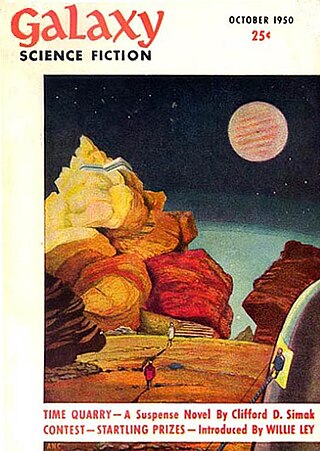
Galaxy Science Fiction was an American digest-size science fiction magazine, published in Boston from 1950 to 1980. It was founded by a French-Italian company, World Editions, which was looking to break into the American market. World Editions hired as editor H. L. Gold, who rapidly made Galaxy the leading science fiction magazine of its time, focusing on stories about social issues rather than technology.
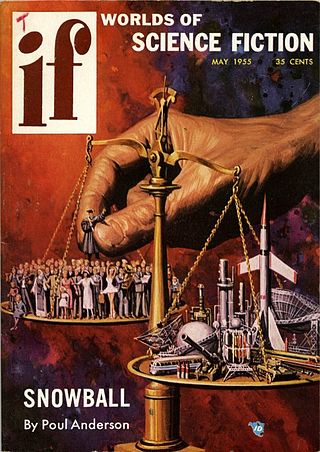
If was an American science fiction magazine launched in March 1952 by Quinn Publications, owned by James L. Quinn.

The Encyclopedia of Science Fiction (SFE) is an English language reference work on science fiction, first published in 1979. It has won the Hugo, Locus and British SF Awards. Two print editions appeared in 1979 and 1993. A third, continuously revised, edition was published online from 2011; a change of web host was announced as the launch of a fourth edition in 2021.
Lester del Rey was an American science fiction author and editor. He was the author of many books in the juvenile Winston Science Fiction series, and the editor at Del Rey Books, the fantasy and science fiction imprint of Ballantine Books, along with his fourth wife Judy-Lynn del Rey.
Alexei Panshin was an American writer and science fiction critic. He wrote several critical works and several novels, including the 1968 Nebula Award–winning novel Rite of Passage and, with his wife Cory Panshin, the 1990 Hugo Award–winning study of science fiction The World Beyond the Hill.
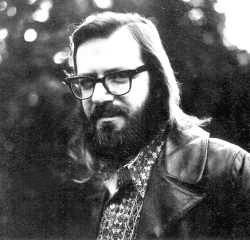
Terry Gene Carr was an American science fiction fan, author, editor, and writing instructor.

The Magazine of Fantasy & Science Fiction is a U.S. fantasy and science fiction magazine, first published in 1949 by Mystery House, a subsidiary of Lawrence Spivak's Mercury Press. Editors Anthony Boucher and J. Francis McComas had approached Spivak in the mid-1940s about creating a fantasy companion to Spivak's existing mystery title, Ellery Queen's Mystery Magazine. The first issue was titled The Magazine of Fantasy, but the decision was quickly made to include science fiction as well as fantasy, and the title was changed correspondingly with the second issue. F&SF was quite different in presentation from the existing science fiction magazines of the day, most of which were in pulp format: it had no interior illustrations, no letter column, and text in a single-column format, which in the opinion of science fiction historian Mike Ashley "set F&SF apart, giving it the air and authority of a superior magazine".

Unknown was an American pulp fantasy fiction magazine, published from 1939 to 1943 by Street & Smith, and edited by John W. Campbell. Unknown was a companion to Street & Smith's science fiction pulp, Astounding Science Fiction, which was also edited by Campbell at the time; many authors and illustrators contributed to both magazines. The leading fantasy magazine in the 1930s was Weird Tales, which focused on shock and horror. Campbell wanted to publish a fantasy magazine with more finesse and humor than Weird Tales, and put his plans into action when Eric Frank Russell sent him the manuscript of his novel Sinister Barrier, about aliens who own the human race. Unknown's first issue appeared in March 1939; in addition to Sinister Barrier, it included H. L. Gold's "Trouble With Water", a humorous fantasy about a New Yorker who meets a water gnome. Gold's story was the first of many in Unknown to combine commonplace reality with the fantastic.

Ace Books is a publisher of science fiction (SF) and fantasy books founded in New York City in 1952 by Aaron A. Wyn. It began as a genre publisher of mysteries and westerns, and soon branched out into other genres, publishing its first science fiction title in 1953. This was successful, and science fiction titles outnumbered both mysteries and westerns within a few years. Other genres also made an appearance, including nonfiction, gothic novels, media tie-in novelizations, and romances. Ace became known for the tête-bêche binding format used for many of its early books, although it did not originate the format. Most of the early titles were published in this "Ace Double" format, and Ace continued to issue books in varied genres, bound tête-bêche, until 1973.
Donald Henry Tuck was an Australian bibliographer of science fiction, fantasy and weird fiction. His works were "among the most extensive produced since the pioneering work of Everett F. Bleiler."

Beyond Fantasy Fiction was a US fantasy fiction magazine edited by H. L. Gold, with only ten issues published from 1953 to 1955. The last two issues carried the cover title of Beyond Fiction, but the publication's name for copyright purposes remained as before.
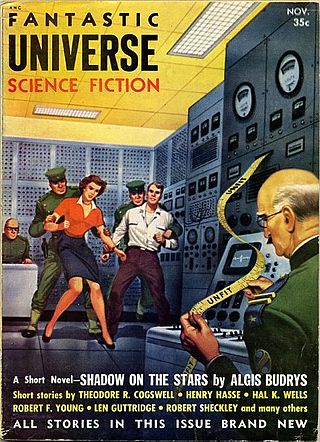
Fantastic Universe was a U.S. science fiction magazine which began publishing in the 1950s. It ran for 69 issues, from June 1953 to March 1960, under two different publishers. It was part of the explosion of science fiction magazine publishing in the 1950s in the United States, and was moderately successful, outlasting almost all of its competitors. The main editors were Leo Margulies (1954–1956) and Hans Stefan Santesson (1956–1960); under Santesson's tenure the quality declined somewhat, and the magazine became known for printing much UFO-related material. A collection of stories from the magazine, edited by Santesson, appeared in 1960 from Prentice-Hall, titled The Fantastic Universe Omnibus.
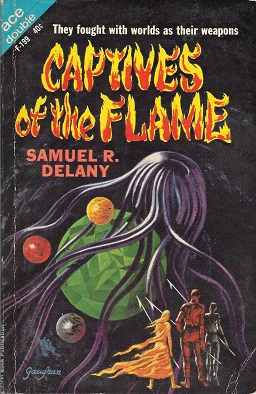
Captives of the Flame is a 1963 science fantasy novel by Samuel R. Delany, and is the first novel in the "Fall of the Towers" trilogy. The novel was originally published as Ace Double F-199 together with The Psionic Menace by Keith Woodcott. It was later rewritten as Out of the Dead City and published by Signet Books in 1968.
Advent:Publishers is an American publishing house. It was founded by Earl Kemp and other members of the University of Chicago Science Fiction Club, including Sidney Coleman, in 1955, to publish criticism, history, and bibliography of the science fiction field, beginning with Damon Knight's In Search of Wonder.
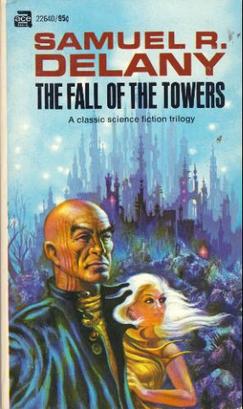
The Fall of the Towers is a trilogy of science fantasy books by American writer Samuel R. Delany.

The Legion of Time is a collection of two science fiction novels by the American writer Jack Williamson. It was first published by Fantasy Press in 1952 in an edition of 4,604 copies. The novels were originally serialized in the magazines Astounding Science Fiction and Marvel Stories.

Stanley Mullen was an American artist, short story writer, novelist and publisher. He studied writing at the University of Colorado at Boulder and drawing, painting and lithography at the Colorado Springs Fine Arts Center where he was accepted as a professional member in 1937. A series of his paintings of Indian ceremonial dances is part of the permanent collection of the Denver Art Museum. Mullen worked as assistant curator of the Colorado State Historical Museum during the 1940s.

The Kingslayer is a collection of science fiction short stories by American writer L. Ron Hubbard. It was first published in 1949 by Fantasy Publishing Company, Inc. in an edition of 1,200 copies. The title story first appeared in this collection. The other stories had previously appeared in the magazine Astounding SF.
The year 1911 was marked, in science fiction, by the following events.

Fantasy was a British science fiction magazine, edited by Walter Gillings, which published three issues from 1946 to 1947. Gillings began collecting submissions for the magazine in 1943, but the publisher, Temple Bar, delayed launching it until the success of New Worlds, another British science fiction magazine, convinced them there was a viable market. Gillings obtained stories from Eric Frank Russell, John Russell Fearn, and Arthur C. Clarke, whose "Technical Error" was the first story of Clarke's to see print in the UK. Gillings published two more stories by Clarke, both under pseudonyms, but Temple Bar ceased publication of Fantasy after the third issue because of paper rationing caused by World War II. Gillings was able to use some of the stories he had acquired for Fantasy in 1950, when he became editor of Science Fantasy.
References
- 1 2 3 M., R. D. (1978). "Review of The Encyclopedia of Science Fiction and Fantasy through 1968". Science Fiction Studies. 5 (2): 182–183. ISSN 0091-7729. JSTOR 4239183.
- 1 2 Post, J. B. (1974). "Review of The Encyclopedia of Science Fiction & Fantasy Through 1968; vol. 1 Who's Who A-L". RQ. 14 (2): 182. ISSN 0033-7072. JSTOR 41354059.
- ↑ "SFE: Advent: Publishers". sf-encyclopedia.com. Retrieved 2022-12-18.
- ↑ "SFE: Tuck, Donald H". sf-encyclopedia.com. Retrieved 2022-12-18.
- ↑ "SFE: Hugo". sf-encyclopedia.com. Retrieved 2022-12-18.